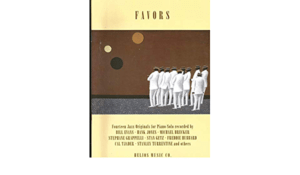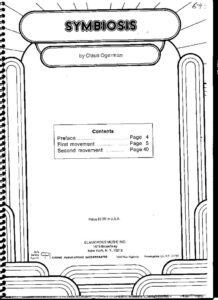Table of Contents
Claus Ogerman (1930-2016)
Come join us now, and enjoy playing your beloved music and browse through great scores of every level and styles!
Can’t find the songbook you’re looking for? Please, email us at: sheetmusiclibrarypdf@gmail.com We’d like to help you!
Claus Ogerman (* April 29, 1930, in Ratibor, † March 8, 2016, in Munich) was a German -American composer and arranger.

Klaus Ogermann was born in Ratibor in Upper Silesia, today’s Racibórz, Poland. He only later gave himself the Anglified name Claus Ogerman in the United States. His parents were Johann (Hans) Ogerman and his wife Emma, born Wrazidlo.
After the end of the Second World War, he and his family moved to the American occupation zone near Nuremberg. Like millions of other German displaced persons and refugees, the family had lost everything, as Ogerman once noticed in an interview on his big CD album The Man Behind The Music.

Best Sheet Music download from our Library.
In the 1950s he worked as an arranger and pianist, including Kurt Edelhagen, Max Greger and Delle Haensch. Under the name ‘Tom Collins’ he also recorded some singles as a singer, both solo and in duet with Hannelore Cremer.
On December 6, 1955, he performed with Chet Baker in the TV studio of the Südwestfunk in Baden-Baden. He also worked as a film composer.

Please, subscribe to our Library.
If you are already a subscriber, please, check our NEW SCORES’ page every month for new sheet music. THANK YOU!
In October 1959, Claus Ogerman moved to New York City. There he met Don Costa, the Ogerman and others. made known with Quincy Jones. Jones (then head of A&R at Mercury Records) hired Ogerman as an arranger and commissioned him with a number of arrangements. In 1962, when the Bossa Nova reached the USA, Ogerman met Antônio Carlos Jobim. With him and other representatives of the Bossa Nova, a long -term work developed together.
Claus Ogerman quickly made a name for himself and worked with various well -known stars of jazz and popular music in the following twenty years. In 1963, he wrote the arrangements for Lesley Gores No.1-Hit it’s my party. During this time, Claus Ogerman developed new forms of arrangement, which were strongly based on classic elements. His unmistakable nature and language, especially for strings, have left a formative impression on the listener.

His cooperation with artists such as Gidon Kremer also shows his innovative strength to achieve new spheres with string textures. On the other hand, his work later met with considerable criticism from this time because of her commercial orientation. In his work in Singer and the Song, the Canadian journalist Gene Lees wrote that he would give Quincy Jones the ‘shit’ that he would ask for people like Gore, and that Ogerman could ‘knock out garbage’ as needed.
The productions under Tommy Lipuma in the 1970s showed the greatest success with regard to its level of awareness as well as with regard to his commercial career as an arranger and composer. In particular, the cooperation with jazz guitarist George Benson was extremely successful. With albums such as Breezin 1976, Inflight 1978 and Living Inside Your Love 1979 (he received a Grammy for the arrangement of the title Soulful Strut), Ogerman took top positions in the sales and radiolists for years.
As an independent work from this genre, his own ballet adaptation Gate of Dreams must also be mentioned, which came to premiere on July 14, 1974 in the Lincoln Center in New York under the name Some Times. The work was produced in 1976, now under the title Gate of Dreams, under its own orchestral name by Tommy Lipuma for the Warner Brother label. Ogerman was able to win artists like George Benson, Joe Sample, Dave Sanborn, Michael Brecker, Peter Maunu, John Guerin, Chuck Dominico, Larry Bunker, Chino Valdes and Ralph Grierson.
In 1974 he wrote with symbiosis a much -noticed piano concert for the jazz pianist Bill Evans, which among other things. with the classic pianist and Bach interpreter Glenn Gould enthusiasm.
In 1979, Claus Ogerman withdrew from the commercial music business and then devoted himself exclusively to the composition of his own works, and the like. For Michael Brecker, Gidon Kremer and for the mezzo-soprano Brigitte Fassbaender.
During this creative period, he rejected the offers of well -known musicians such as Prince, Ella Fitzgerald, Dee Dee Bridgewater, Wynton Marsalis, Tony Bennett, Till Brönner and others to produce and arrange albums for them.
It was only in 2001 that producer Tommy Lipuma managed to move the Canadian jazz pianist Diana Krall to return to the commercial music business to return to the commercial music business.
Claus Ogerman Orchestrated and arranged for Diana Krall the album The Look of Love, later her album Quiet Nights, which was held in the style of the Bossa Nova recordings of the 1960s. It was awarded a Grammy in the best instrumentary arrangement category. 2010.
In the decades of his work, Ogerman developed a very successful style of orchestration and arrangement influenced by classic elements. New arrangements of well-known melodies, which are now used for music sprinkling in elevators, hotels, and shopping centers (Muzak), are often based on Ogerman’s concepts.
Ogerman worked with many well -known musicians from 1958 to 1979 and arranged and produced their albums. Stan Getz, Astrud Gilberto, João Gilberto, and Sammy Davis Jr. are to be emphasized.
Billie Holiday, Lady in Satin (1958),
Leroy Holmes, Bossa Nova (1962) - with his own compositions Morena, Tabatinga, the Jazz Samba and Nocturne
Bill Evans: Plays The Theme From The V.I.P.S and other Great Songs (1963)
Cal Tjader, Warm Wave (1964) - With the own composition Sunset Boulevard (1964)
Bill Evans & Jim Hall, intermodulation (1966) - with the own composition The Jazz Samba
Bill Evans Trio with Symphony Orchestra (1966) - with its own composition Elegia (ELEDY)
Wes Montgomery, Tequila (1966)
Francis Albert Sinatra & Antônio Carlos Jobim (1967)
Connie Francis Sings Bacharach & David (1968)
Oscar Peterson, Motions and Emotions, MPS (1969)
Barbra Streisand, Stoney End (1971)
Hank Jones, Hanky Panky (1975) - with the own composition of Favors
Bill Evans, Intuition (1975) - With its own composition A Face Without a name
Barbra Streisand, Classical Barbra (1976) - With his own composition I Loved You
Michael Franks, Sleeping Gypsy (1977)
Stanley Turtrentine, Nightwings (1977) - with the own compositions Nightwings and Don't Give Up on Us
Stéphane Grappelli, Uptown Dance (1978) - With their own compositions uptown dance and favorites
Jan Akkerman, Aranjuez (1978) - With the own composition of Nightwings
Freddie Hubbard, The Love Connection (1979) - With the own composition of this Dream
George Benson, Livin ’Inside Your Love (1979)
Diana Krall, The Look of Love (2001)
Diana Krall, Quiet Nights (2009)Ogerman’s best -known classic -oriented albums with own compositions are:
1974 - symbiosis, for jazz piano and orchestra, with Bill Evans
1977 - Gate of Dreams
1982 - CityScape for saxophone and orchestra, with Michael Brecker
1982 - Elegia, Lyric Suite, Preludio & Chant, Symphonic Dances, I Loved You, with Gidon Kremer (violin), Marilyn Schmiege (Mezzosopran) and the London Symphonic Orchestra, Head of Claus Ogerman
1985 - Choir songs based on texts by Georg Heym, album of the Cologne Radio Choir
1988 - Brigitte Fassbaender, songs by Gustav Mahler, Alban Berg and Claus Ogerman, with John Wustman (piano) [9]
1992 - Symphonic Dances, Some Times (Ballet), with The New York Studio Symphony Orchestra
2007-Violin and Piano Works, with Yue Deng (violin) and Jean-Yves Thibaudet (piano)-Decca
2008 - Across the Crystal Sea, with Danilo PérezBrowse in the Library:
Or browse in the categories menus & download the Library Catalog PDF:
Antonio Carlos Jobim & Claus Ogerman
Samba de uma nota só: 0:05 Meditation: 2:20 Two tracks from the LP “Antonio Carlos Jobim The Composer Of Desafinado Plays”, 1963. An album with orchestral versions of popular bossa nova themes. Arrangements by Claus Ogerman
Diana Krall Claus Ogerman
Diana Krall – Live in Paris (2002) 1.”‘S Wonderful” 2. “Love Letters”
Legendary arranger Claus Ogerman was reactivated by special demand from Diana. He refused many requests by international Top Stars. After many years, Diana Krall convinced him to arrange two albums for her. Thanks for this, Diana! Ogerman arranged many albums by A. C. Jobim in the 60ies and 70ies, e.g. “Wave”.
